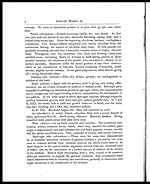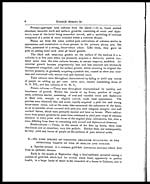Medicine - Institutions > Army health reports and medical documents > Scientific memoirs by medical officers of the Army of India > Part X, 1897 > 1 - Choleraic and other commas; on the influence of certain conditions in determining morphological variations in vibrionic organisms
(11) Page 5
Download files
Individual page:
Thumbnail gallery: Grid view | List view

Medical Officers of the Army of India .
5
Cultivations in 10 per cent. common gelatine:—Are accompanied by the
formation of an evenly tapering column of liquefaction along the whole course
of the track in stab-cultures, the sides of which are densely clouded by adherent
growths and the lower part occupied by a very copious deposit.
Cultivations on potatoes:—Growth primarily occurred readily and rapidly, in
the form of very moist, relatively thin, pale yellow expansions, which were
specially distinguished from the growths of any other form of choleraic commas
on similar media, by being from the outset of a very frothy character. Later
growths failed to show this, forming even and firmer, yellow, thalloid expansions
with lobulated margins more or less similar to those characteristic of sp. β .
Somewhat later cultures yielded feebler and feebler, growths, until, after a time,
all appreciable evidence of any growth whatever completely disappeared.
The characters of the elements varied considerably in different instances.
Where growth took place very rapidly and luxuriantly, the elements were almost
all of uniformly coccoid character; where it occurred somewhat more slowly,
diplococcoid elements and short rods, straight or slightly curved and evi-
dently composed of closely aggregated cocci, were present in abundance; and,
in those cases in which the growth was greatly retarded, commas consisting of
three or four cocci included within a common sheath formed the characteristic
feature.
Cultivations in neutral broth:—Within 24 hours these were lightly clouded
and covered by a membranous pellicle, and gave strong purple, in the lower half,
on the addition of pure sulphuric acid.
Cultivations in common gelatine:—Within 48 hours show an almost
evenly outlined, tapering column of liquefaction along the whole length of
the track, the walls being opaque and white, and the fluid giving beautiful purple
with pure sulphuric acid. Very abundant deposit.
G. H. XXII. Stool received 18th April 1896 and examined 19th April.
A typical rice-water stool, consisting of a large quantity of watery, almost
colourless fluid; giving beautiful, pure, bright purple with nitric or sulphuric
acid, and a very scanty sediment of greyish flocculi.
Primary plate cultures:—These yielded innumerable colonies, both super-
ficial and interstitial, and apparently all of one type. The superficial ones were
of moderate size, bluish tint, and, where of any considerable size, had a thinner
central area, and a thicker, more opaque, somewhat sinuous margin. They
were further characterised by possessing a strong, bitter-sweet, disagreeable
odour, somewhat resembling that characteristic of the potato-growths of certain
other species, but quite unique as a peculiarity of agar-agar growths, save in
the case of the earlier plates of G. H. XVIII. They consisted of relatively
large, well curved, thickish commas. Up to 48 hours they gave not a trace
of pink on adding 33 per cent. nitric acid.
Set display mode to: Large image | Zoom image | Transcription
Images and transcriptions on this page, including medium image downloads, may be used under the Creative Commons Attribution 4.0 International Licence unless otherwise stated. ![]()
| Permanent URL | https://digital.nls.uk/75003075 |
|---|
| Shelfmark | IP/QB.10 |
|---|---|
| Additional NLS resources: | |




